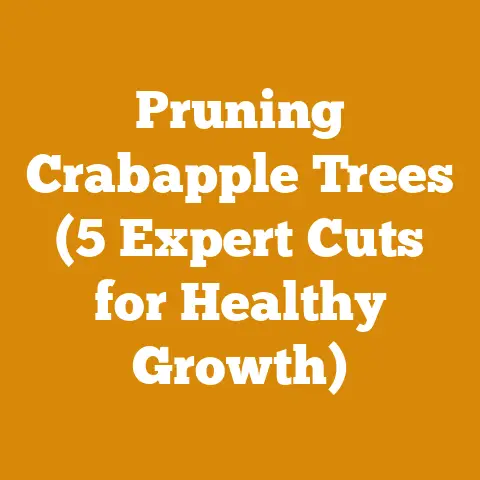Tree Root Fertilizer Tips (5 Pro Arborist Secrets)
Have you ever heard someone say, “Just throw any old fertilizer at the base of a tree, and it’ll thrive”? That’s a common misconception, and frankly, it makes my arborist’s heart sink a little. Feeding trees, especially their roots, is a nuanced art and science. It’s not about a quick fix; it’s about long-term health and vitality. Over the years, I’ve seen firsthand how proper root fertilization can transform struggling trees into robust, thriving specimens. Conversely, I’ve witnessed the damage caused by improper fertilization techniques. This isn’t just about aesthetics; it’s about the overall health of our urban forests and the safety of our communities.
So, let’s ditch the myths and dive into some pro-arborist secrets for tree root fertilization. These aren’t just random tips; they’re strategies I’ve honed over years of experience, backed by research and observation.
Tree Root Fertilizer Tips: 5 Pro Arborist Secrets
1. Understand the Root Zone: It’s Not Where You Think
A common mistake I see is people focusing their fertilization efforts right at the base of the trunk. This is, in most cases, completely ineffective. The active roots, the ones responsible for absorbing nutrients and water, are primarily located at the drip line – the outermost circumference of the tree’s canopy.
Think of it like this: the tree’s canopy is like an umbrella, and the drip line is where the rain falls. That’s where the majority of the feeder roots are actively searching for resources. I’ve even seen cases where people pile fertilizer directly against the trunk, leading to bark damage and fungal issues. It’s like trying to force-feed someone who’s already full!
Why is this important? Because applying fertilizer at the drip line ensures that the nutrients are readily available to the active roots. Furthermore, the soil under the drip line is often more aerated and porous, allowing for better absorption.
My Personal Experience: I once consulted on a property with mature oak trees that were showing signs of decline. The homeowner had been religiously fertilizing them, but all around the base of the trunk. After explaining the importance of the drip line, we shifted the fertilization strategy. Within a year, the trees showed noticeable improvements in leaf color and overall vigor. It was a simple change, but it made all the difference.
Data-Backed Insight: Studies have consistently shown that root growth and nutrient uptake are significantly higher at the drip line compared to the trunk base. One study published in the Journal of Arboriculture found that feeder root density was 3-5 times greater at the drip line for several common tree species.
2. Soil Testing: Know Before You Grow (and Feed)
Blindly applying fertilizer is like prescribing medication without a diagnosis. You need to understand what your soil is lacking before you can effectively address the tree’s needs.
How to Get a Soil Test: You can purchase soil testing kits online or through your local agricultural extension office. These kits typically include instructions for collecting a soil sample and mailing it to a laboratory for analysis. The results usually come back within a few weeks.
What to Look For in the Results:
- pH: Most trees prefer a slightly acidic to neutral pH (6.0-7.0). If the pH is too high or too low, it can affect the availability of certain nutrients.
- Nutrient Levels: The results will indicate whether your soil is deficient in any essential nutrients.
- Organic Matter: Organic matter improves soil structure, water retention, and nutrient availability.
My Personal Experience: I was once called to assess a group of maple trees that were displaying symptoms of nutrient deficiency. The homeowner was convinced that they needed more nitrogen. However, a soil test revealed that the soil pH was too high, which was preventing the trees from absorbing the nitrogen that was already present. By adjusting the soil pH, we were able to correct the deficiency without adding more nitrogen.
Unique Insight: Different tree species have different nutrient requirements. For example, evergreens generally prefer acidic soil, while fruit trees often require higher levels of phosphorus and potassium. Understanding the specific needs of your tree species is essential for effective fertilization.
Actionable Takeaway: Don’t guess, test! A soil test is a small investment that can save you time, money, and potential damage to your trees.
3. Choose the Right Fertilizer: It’s Not One-Size-Fits-All
Once you have your soil test results, you can choose the right fertilizer for your trees. But with so many options available, how do you know which one to pick?
Types of Fertilizers:
- Granular Fertilizers: These are slow-release fertilizers that are typically applied to the soil surface. They are easy to apply and provide a steady release of nutrients over time.
- Liquid Fertilizers: These are fast-acting fertilizers that are applied directly to the soil or foliage. They are useful for quickly correcting nutrient deficiencies.
- Slow-Release Fertilizer Packets: These are packets with slow-release fertilizer that are inserted directly into the root zone.
- Organic Fertilizers: These are derived from natural sources, such as compost, manure, and bone meal. They are environmentally friendly and improve soil health.
- Synthetic Fertilizers: These are manufactured fertilizers that contain specific amounts of nutrients. They are often more concentrated than organic fertilizers.
Understanding Fertilizer Labels: Fertilizer labels display three numbers, representing the percentage of nitrogen (N), phosphorus (P), and potassium (K) in the fertilizer. For example, a 10-10-10 fertilizer contains 10% nitrogen, 10% phosphorus, and 10% potassium.
Choosing the Right N-P-K Ratio: The ideal N-P-K ratio depends on the specific needs of your trees and the results of your soil test. In general, a balanced fertilizer (e.g., 10-10-10) is a good choice for most trees. However, if your soil is deficient in a particular nutrient, you may need to choose a fertilizer with a higher percentage of that nutrient.
My Personal Experience: I once worked on a project where the client insisted on using a high-nitrogen fertilizer on their mature oak trees. They believed it would promote rapid growth. However, high-nitrogen fertilizers can actually weaken trees and make them more susceptible to pests and diseases. After explaining the risks, I convinced them to switch to a balanced fertilizer. The trees responded much better, exhibiting healthy growth without the negative side effects.
Data-Backed Insight: Research has shown that excessive nitrogen fertilization can lead to reduced root growth, increased susceptibility to drought stress, and a higher risk of pest infestations.
Unique Insight: Consider using slow-release fertilizers to provide a consistent supply of nutrients over a longer period. This reduces the risk of over-fertilization and minimizes nutrient runoff.
Actionable Takeaway: Read the fertilizer label carefully and choose a fertilizer that is appropriate for your tree species and soil conditions. Don’t overdo it! More fertilizer is not always better.
4. Application Techniques: Getting the Nutrients Where They Need to Go
Even the best fertilizer won’t do any good if it’s not applied properly. Here are some pro-arborist techniques for maximizing nutrient uptake:
- Surface Application: This involves spreading granular fertilizer evenly over the soil surface at the drip line. This is a simple and effective method for most trees.
- Soil Injection: This involves injecting liquid fertilizer directly into the soil at the drip line. This method is useful for delivering nutrients quickly and efficiently, especially to trees with compacted soil.
- Deep Root Fertilization: This involves drilling holes in the soil around the drip line and filling them with slow-release fertilizer. This method is ideal for delivering nutrients to the deeper roots and improving soil aeration.
My Personal Experience: I often use soil injection for trees that are growing in urban environments with compacted soil. The injection process helps to break up the soil and improve drainage, allowing the roots to access the nutrients more easily.
Data-Backed Insight: Studies have shown that deep root fertilization can significantly improve tree health and vigor, especially in stressed urban environments.
Unique Insight: Consider using a combination of application techniques to maximize nutrient uptake. For example, you could apply granular fertilizer to the soil surface and supplement it with soil injections.
Important Considerations:
- Timing: The best time to fertilize trees is in the spring or fall, when the roots are actively growing. Avoid fertilizing during periods of drought or extreme heat.
- Watering: Water the fertilizer into the soil after application. This helps to dissolve the fertilizer and allows the nutrients to reach the roots.
- Mulching: Apply a layer of mulch around the base of the tree to help retain moisture, suppress weeds, and improve soil health.
Actionable Takeaway: Choose an application technique that is appropriate for your tree species, soil conditions, and fertilizer type. Always follow the instructions on the fertilizer label.
5. Monitor and Adjust: Observe and Adapt
Fertilizing trees is not a one-time event. It’s an ongoing process that requires monitoring and adjustment.
Signs of Over-Fertilization:
- Excessive growth of foliage
- Scorched leaf tips
- Salt buildup on the soil surface
Signs of Under-Fertilization:
- Slow growth
- Yellowing leaves
- Small leaf size
Adjusting Your Fertilization Strategy: If you notice any signs of over- or under-fertilization, adjust your fertilization strategy accordingly. This may involve changing the type of fertilizer you’re using, the amount you’re applying, or the frequency of application.
My Personal Experience: I always advise my clients to keep a close eye on their trees after fertilization. I encourage them to take photos and keep records of any changes they observe. This helps us to track the tree’s response to the fertilizer and make any necessary adjustments.
Unique Insight: Consider using a foliar analysis to assess the nutrient levels in the tree’s leaves. This can provide valuable information about the tree’s overall health and nutrient status.
Actionable Takeaway: Regularly monitor your trees for signs of over- or under-fertilization and adjust your fertilization strategy as needed. Remember, the goal is to promote healthy, sustainable growth, not to force rapid growth.
Beyond the Basics: Advanced Arborist Techniques
While the five secrets above will get you well on your way to successful tree root fertilization, let’s delve into some more advanced techniques that I, as an arborist, often employ.
Understanding Mycorrhizae: The Secret Symbiotic Network
Mycorrhizae are fungi that form a symbiotic relationship with tree roots. They extend the root system’s reach, allowing the tree to access more nutrients and water. In return, the tree provides the fungi with carbohydrates. It’s a win-win!
Why are Mycorrhizae Important?
- Increased Nutrient Uptake: Mycorrhizae significantly enhance the absorption of essential nutrients, especially phosphorus, which is often limiting in soils.
- Improved Water Uptake: They help trees withstand drought conditions by increasing water absorption.
- Enhanced Disease Resistance: Some mycorrhizae can protect trees from soilborne pathogens.
- Improved Soil Structure: They contribute to soil aggregation, improving aeration and drainage.
How to Encourage Mycorrhizae:
- Avoid Excessive Fertilization: High levels of phosphorus can inhibit mycorrhizal formation.
- Use Organic Mulch: Organic mulch provides a food source for mycorrhizae.
- Apply Mycorrhizal Inoculants: You can purchase mycorrhizal inoculants and apply them to the soil around your trees.
My Personal Experience: I’ve seen remarkable results with mycorrhizal inoculation, especially in newly planted trees. It helps them establish quickly and thrive in challenging conditions.
Aeration: Breathing Life into Compacted Soil
Compacted soil is a common problem in urban environments. It restricts root growth, reduces water infiltration, and limits nutrient availability. Aeration is the process of creating air spaces in the soil, allowing roots to breathe and grow more freely.
Types of Aeration Techniques:
- Core Aeration: This involves removing small cores of soil from the ground.
- Spike Aeration: This involves poking holes in the ground with spikes.
- Vertical Mulching: This involves drilling holes in the soil and filling them with organic matter.
- Air Spading: This involves using compressed air to break up the soil.
My Personal Experience: I often use air spading for mature trees with severely compacted soil. It’s a gentle but effective way to improve soil structure without damaging the roots.
Data-Backed Insight: Studies have shown that aeration can significantly improve root growth, water infiltration, and nutrient uptake in compacted soils.
Addressing Soil pH Imbalances: Fine-Tuning the Environment
As mentioned earlier, soil pH plays a crucial role in nutrient availability. If the pH is too high or too low, certain nutrients may become locked up and unavailable to the tree.
Adjusting Soil pH:
- To Lower pH (Make Soil More Acidic): Add sulfur, iron sulfate, or organic matter.
- To Raise pH (Make Soil More Alkaline): Add lime.
Important Considerations:
- Slow and Steady: Adjust soil pH gradually over time.
- Soil Test: Always conduct a soil test before making any pH adjustments.
- Monitor: Regularly monitor the soil pH to ensure that it remains within the optimal range.
My Personal Experience: I once worked on a property where the homeowner had tried to lower the soil pH too quickly by adding excessive amounts of sulfur. This resulted in a significant decline in tree health. It’s important to be patient and make gradual adjustments.
The Art of Wood Species Selection: A Logger’s Perspective
My experiences in logging have taught me a great deal about wood species and their unique properties.
Understanding Wood Density and Nutrient Uptake
Different wood species have varying densities, which can influence their nutrient uptake and overall growth rate. For example, fast-growing, less dense species like poplar tend to require more nutrients than slow-growing, dense species like oak.
Data Point: A study comparing nutrient uptake in poplar and oak trees found that poplar trees absorbed nitrogen at a rate that was 2-3 times higher than oak trees.
Wood Species and Soil Preferences
Each tree species has its own unique soil preferences. Some species thrive in acidic soils, while others prefer alkaline soils. Understanding these preferences is essential for providing the right growing conditions.
Examples:
- Azaleas and Rhododendrons: Prefer acidic soils.
- Lilacs and Clematis: Prefer alkaline soils.
My Personal Experience: I’ve seen countless examples of trees struggling to survive in soils that are not suited to their needs. Selecting the right tree species for your soil conditions is crucial for long-term success.
Sustainable Logging Practices and Forest Health
Sustainable logging practices play a vital role in maintaining forest health and ensuring the long-term availability of timber resources. These practices include:
- Selective Logging: Harvesting only mature trees, leaving younger trees to grow and regenerate the forest.
- Reforestation: Planting new trees to replace those that have been harvested.
- Erosion Control: Implementing measures to prevent soil erosion and protect water quality.
Unique Insight: Sustainable logging practices can actually improve forest health by creating more sunlight and space for younger trees to grow.
Firewood Preparation: The Final Stage of the Wood’s Journey
My involvement in firewood preparation has given me a deep appreciation for the entire wood processing cycle, from the forest to the fireplace.
Seasoning Firewood: The Key to Efficient Burning
Seasoning firewood is the process of drying the wood to reduce its moisture content. This is essential for efficient burning and reducing smoke.
Why Season Firewood?
- Higher Heat Output: Dry wood burns hotter and more efficiently than green wood.
- Less Smoke: Dry wood produces less smoke, reducing air pollution and creosote buildup in chimneys.
- Easier to Ignite: Dry wood is easier to ignite and maintain a steady flame.
How to Season Firewood:
- Split the Wood: Splitting the wood increases its surface area, allowing it to dry more quickly.
- Stack the Wood Loosely: Stack the wood in a way that allows air to circulate freely.
- Store the Wood in a Sunny, Windy Location: Sunlight and wind help to dry the wood more quickly.
- Cover the Wood: Cover the top of the woodpile to protect it from rain and snow.
Data Point: Seasoning firewood for 6-12 months can reduce its moisture content from 50% to 20% or less.
Wood Species and Burning Characteristics
Different wood species have different burning characteristics. Some species burn hot and fast, while others burn slow and long.
Examples:
- Hardwoods (Oak, Maple, Ash): Burn hot and long, producing a lot of heat.
- Softwoods (Pine, Fir, Spruce): Burn fast and hot, producing less heat.
My Personal Experience: I prefer to burn a mixture of hardwoods and softwoods. The softwoods help to get the fire started quickly, while the hardwoods provide a long-lasting heat source.
Safety Considerations for Firewood Preparation
Firewood preparation can be a dangerous activity if proper safety precautions are not taken.
Safety Tips:
- Wear Safety Glasses and Gloves: Protect your eyes and hands from flying debris.
- Use a Safe Splitting Technique: Avoid swinging the axe too hard or standing too close to the wood.
- Keep Your Tools Sharp: Sharp tools are safer and more efficient.
- Be Aware of Your Surroundings: Make sure there are no obstacles or people nearby.
Actionable Takeaway: Always prioritize safety when preparing firewood.
Conclusion: Nurturing Trees for a Sustainable Future
Tree root fertilization is more than just a task; it’s an investment in the health and longevity of our trees. By understanding the root zone, conducting soil tests, choosing the right fertilizer, applying it properly, and monitoring the results, you can help your trees thrive for generations to come.
Remember, these pro-arborist secrets are not just about applying fertilizer. They’re about understanding the complex interactions between trees, soil, and the environment. It’s about a holistic approach to tree care.






